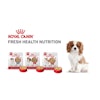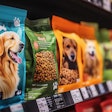
Raw pet food continues to increase in popularity, but also continues to present a risk of infection by disease-causing bacteria, such as Salmonella. Scientists recently demonstrated that viruses, called bacteriophages or phages, can knock down Salmonella levels in raw pet food ingredients and are safe for dogs and cats to eat.
Bacteriophages are viruses that infect bacteria. Since phages live nearly everywhere on Earth, they can meet consumers’ demands for pet foods made using natural ingredients without synthetic chemicals, wrote the researchers in the journal "Bacteriophage."
“There is a small but growing number of manufacturers, in both the US and Canada, that are using bacteriophages in their pet food production,” lead study author Nitzan Soffer, research scientist at Intralytix, told Petfood Industry.
“Initial interest was from high-end pet food producers specializing in providing chemical-free or limited chemical, natural and organic pet foods, although other pet food companies are increasingly interested in adding bacteriophages to their arsenal of tools designed to ensure the safety of the pet foods they produce.”
Phage experiment in dog and cat foods
Phages were approved for use in human foods before pet foods under the FDA’s Generally Recognized as Safe (GRAS) rule. Several phage formulations are available from Intralytix.
Soffer and her research team used one of those products, SalmoLyse, to fight Salmonella contamination in various raw pet food ingredients, including raw chicken, turkey, tuna, cantaloupe and lettuce. The ingredients were contaminated with either a single Salmonella strain (turkey meat) or a mixture of three Salmonella strains found in raw chicken, tuna, cantaloupe and lettuce.
Spraying the ingredients with phages reduced Salmonella by 60 percent to 92 percent depending on the ingredient and concentration of phage used. Generally, the stronger the concentration of phages in the spray, the more effective it was in reducing Salmonella, regardless of the ingredient.
In the feeding portion of Soffer’s study, 12 dogs and 12 cats were fed dry kibble treated with phages. None of the phage-fed animals showed signs of illness or digestive problems during the two-week study.
Phage limitations solved with cocktails
As the Food Safety Modernization Act continues to affect pet food safety, Soffer said that bacteriophages can help raw pet food manufacturers comply with food safety legislation . However, phages have limitations.
“They are not a silver bullet,” Soffer said. “They should be used in conjunction with other antimicrobial methods to reduce or eliminate the pathogens."
Bacteriophages infect only specific bacteria, so one phage product, such as SalmoLyse, will attack Salmonella in pet foods and treats, but won’t affect other disease-causing bacteria, such as Listeria monocytogenes or Escherichia coli. To solve this problem, combinations of phages can be made into a cocktail to go after different bacteria species.
“On the other hand, because of this specificity, bacteriophages will not impact normal flora, and often beneficial, bacteria in pet foods, and therefore will not deleteriously impact the nutritional value of those foods,” said Soffer.
How to use phages in pet food manufacturing
For pet food manufacturers thinking about using phages, Soffer noted a few considerations. For one, phages cannot withstand high temperatures or prolonged exposure to UV light. As with human food, pet food manufacturers also use bacteriophages under a self-reported GRAS declaration.
“The timing of the addition of bacteriophages varies with the production procedure,” said Soffer. “We currently work with our customers to determine the best timing and usage of our bacteriophage products. For example, for raw pet foods that will be ground, phage is typically applied on the big food chunks immediately prior to grinding. For processed pet foods, the phage application typically occurs later in the processing stage, right before packaging.”
Research funding
Soffer’s research was funded by both Intralytix and Proctor and Gamble.
















